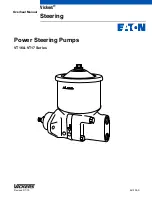
Page 3
www.vaki.is
PPRREEFFAAC
CEE –– SSm
maarrttFFlloow
w
Grading live fish is a fairly hard and complicated process. The system normally
consists of three to four grades where the operator can dynamically adjust the grades
on the fly. The system falls under the category of a multi input, multi output system
(MIMO). The system is operated by two to four persons at a time and it is sensitive to
any changes, a small change to the input can cause a dramatic change in the output
and it’s not uncommon that 100 of
thousands
of fish are graded in one session
and
t
he
size range varies from few grams
to a few
hundred grams.
All these factors contribute in making the system fairly complicated and hard to tune
and more often than not results in
an unsatisfactory
output. It requires a lot of
knowledge about the system and a lot of practice to obtain a reasonable result.
SmartFlow connects all the devices used for grading fish in a hatchery to allow for an
automatic grading. SmartFlow is a control system that optimizes the grading process
by controlling the entire process. With SmartFlow you only need one person to
operate the whole system with fundamental knowledge of grading. You can control all
aspects of the grading from
within SmartFlow. Enter in your desired output and the
system takes care of the rest.
Set up
When setting up SmartFlow the following
system configuration is
required
:
●
A VAKI counter (Micro/Macro/EXEL).
●
A VAKI Smart
G
rader
●
A VAKI pump
●
A VAKI density controller
●
SmartFlow configured and running on
the
counter.
VAKI Fish Pump Manual
Page 4
www.vaki.is
VAKI Smart Grader
The Smart Grader delivers accurate fish grading while minimizing the impact on your
fish as they pass through the outlets. The dewatering unit distributes the fish evenly
over the width of the grader, so all 10 tracks are used effectively.
Further the inclination of the main sorting unit can be adjusted from 5-14° with an
electric actuator. The opening of the grader is controlled with electric linear actuators
that can be manually operated from a control panel on the grader or automatically
from the VAKI Counter which counts, size measures and calculates the split between
the grades. The opening for each grade is displayed on a digital display. The grader is
built in high grade stainless steel 316L and selected plastic materials that are corrosion
and water resistant.
The rollers are machined with high precision laser welding tools and balanced out with
specialized equipment. It delivers an accurate grading of the fish. The outlets are
designed to minimize the impact on the fish and can be mounted to deliver the fish on
either side of the grader. These outlets can easily be removed for cleaning. The
rotation speed of the rollers can be adjusted with a frequency controller.
The grader functions by sliding the fish between two rolls, where the distance
between them gradually widens. Where two pairs of rollers rotate away from each
other to make sure that the fish doesn’t get squeezed between the rollers, but instead
lifted up and pushed forward so they fall through in the correct place. The expansion
of the slits on both ends can be adjusted. When operating the grader you have to
keep in mind that the grades are all related to one another. One single grader gap
VAKI Fish Pump Manual
Page 1
www.vaki.is
Waste management
Sort and recycle electronics and batteries to reduce waste and conserve resources. Many elec-
tronics contain hazardous chemicals that must be handled appropriately, as well as precious
metals that can be used again.
Contents
1. Warranty Terms of VAKI Fish Pump .........................................................................3
2. Environment................................................................................................................4
3. Explanation of Parts ...................................................................................................5
3.1 Pump Body .....................................................................................................................5
3.2 Main Motor .....................................................................................................................5
3.3 Priming motor .................................................................................................................5
3.4 Priming tank ...................................................................................................................6
3.5 Priming pump .................................................................................................................6
3.6 Control cabinet ...............................................................................................................6
3.7 Remote Control ..............................................................................................................7
3.8 Valves .............................................................................................................................8
3.9 Connections and Reducers ............................................................................................8
3.10 Parts Pack ....................................................................................................................8
3.11 Rubber Wheel...............................................................................................................9
4. Use of VAKI Fish Pump ..............................................................................................9
4.1 Electric model .................................................................................................................9
4.2 Maintenance .................................................................................................................10
4,3 Wiring Diagram



























